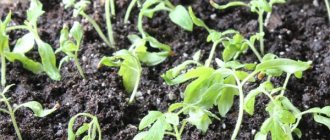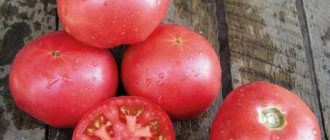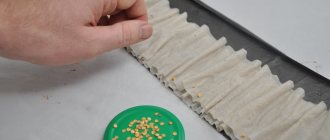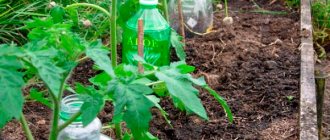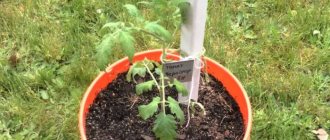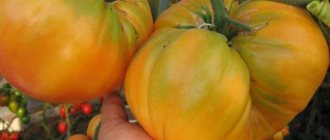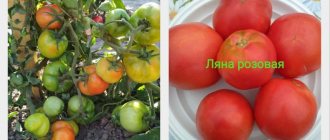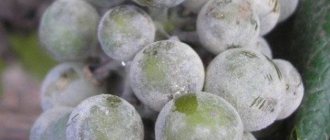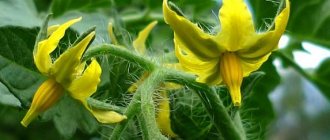International name:
Synonyms:
Characteristics:
| Complexity: |
| Development cycle: |
| Light mode: |
| Watering mode: |
| Temperature: |
| The soil: |
| Key Feature: |
Foliage color
Bud color
Dimensions Flower sizes
Taxonomy:
| Domain: |
| Kingdom: |
| Department: |
| Class: |
| Order: |
| Family: |
| Genus: |
Spring comes, and almost everyone awakens to the desire to sow and grow flowers and vegetables with their own hands. Many people have greenhouses, summer cottages or personal plots for this, but before planting the plant in the “freedom”, you need to prepare the seedlings. It all starts with a small seed...
The article will reveal in detail each stage of this fascinating process, and in the end, you will receive stress-resistant and high-quality tomato seedlings at home on the windowsill.
When to sow?
Experienced vegetable growers recommend sowing tomato seeds approximately 60 days before the planned transplantation of seedlings into a greenhouse or into beds.
It is very important to sow the seeds in a timely manner, since it is not recommended to overexpose tomato seedlings at home. This also entails a reduction in future yield.
Preparing tomato seeds for sowing seedlings
Traditionally, pre-sowing treatment is recommended for tomato seeds. It doesn't matter here whether they are homemade or purchased. Both can carry pathogens, both fungal and bacterial.
This point should not be neglected, especially since seed processing does not take long and does not require significant labor costs.
The simplest and most proven method of disinfection is to soak the seeds in a bright pink solution of potassium permanganate for 2-3 minutes. After which they need to be washed under running water and dried on a paper towel.
Many gardeners also welcome the stimulating soaking of seeds in HB-101. It is necessary to dilute it strictly according to the instructions and leave the seeds in it for 10 minutes. This improves seed germination as well as sprout vigor.
Pre-sowing seed treatment
Before sowing, seeds should be treated with special disinfecting solutions. However, not all seeds require processing; seed material from leading manufacturers generally undergoes a similar procedure at the enterprise before packaging.
A weak solution of potassium permanganate (1 gram of potassium permanganate is dissolved in 100 milliliters of water) is ideal for disinfecting seed material; the seeds are kept in this composition for 20 minutes.
In addition to potassium permanganate, you can use a soda solution to disinfect seed material (0.5 grams of soda is thoroughly dissolved in 100 milliliters of water, the seeds are soaked in this composition for a day).
Soil preparation and seeding containers
It is better to prepare the soil in the fall. Here are the commonly used soil mixture options:
- Garden turf soil + humus + black or pressed peat (1:1:1) + wood ash (0.5 liters of ash per 1 bucket of soil mixture) + superphosphate (2 matchboxes per 1 bucket of soil), moisten the mixture with water.
- Garden soil + river sand + black or pressed peat (or compost) (1:1:1) + aqueous solution of mineral fertilizers (10 liters of water + 20 g of potassium sulfate + 10 g of urea + 30 g of superphosphate).
- Sand + field soil + manure humus + well-decomposed weathered peat (1: 1: 1: 1) + lime 15–18 g + “Universal” fertilizer 100 g per 1 bucket of mixture.
- Any soil mixture purchased at the store. High-quality ready-made soil contains all the necessary additives and nutrients; there is no need to mix it with anything.
Container for growing seedlings:
- cut plastic bottles;
- ordinary plastic cups;
- plastic pots;
- wooden boxes, film pots;
- peat pots;
- grocery bags and cups;
- homemade bags without a bottom made of film or paper.
The holes for water drainage should be large enough so that the water does not stagnate and the root system does not die off. To control watering, it is good when the walls of the pot are transparent.
The pots are filled with soil mixture, poured over with boiling water and allowed to cool. Now they are ready for planting.
Preparation of planting soil
Every gardener knows very well that the soil also needs to be disinfected, especially if it is dug up from the garden. Of course, you can use soil purchased at a specialized retail outlet, however, to avoid surprises, it should also be processed.
There are several ways to disinfect the soil:
- Heat in the oven at high temperature (about 200 degrees) for 15 minutes.
- Pour boiling water over the soil. To do this, the soil must be placed in a special container with drainage holes.
- An excellent solution for soil treatment is a solution of strong potassium permanganate. The mixture must be poured onto the prepared soil.
To obtain a more reliable result, several methods should be used simultaneously.
Is it necessary to grow tomatoes from seedlings?
The growing season for tomatoes is very long; many months pass from sowing seeds to harvesting, and all work on growing tomatoes begins in March, when spring has not yet really begun in most of our country. Therefore, unfortunately, almost nowhere you can’t do without growing seedlings.
When in the 1980s We, graduates of Moscow State University, assigned to Saratov, acquired dacha plots; one friend could not understand the meaning of the word “seedlings”. And I certainly didn’t want to believe that tomato seeds must first be planted in a pot or box, and then nurtured and cherished in the apartment. In their village, on the Azov coast, where the shaft also sprouts, there were only two stages of growing tomatoes: plant the seeds in a garden bed and harvest.
In the conditions of central Russia, and even more so in the northern regions, growing seedlings is mandatory. Fortunately, unlike cabbage, which requires low temperatures (from 6 to 16 °C) to grow seedlings, tomatoes are fine in this regard: the conditions of a city apartment are generally suitable for seedlings, only sometimes there is not enough sun. Therefore, for about two months a year, gardeners occupy all the free space in the apartment with boxes and cups with tomato seedlings.
Sowing seeds
After treatment, the soil should be watered well and kept in a warm room for several days. This will allow beneficial bacteria to multiply in the soil.
Special containers must be filled with soil, shallow holes made and seeds placed in them at a short distance from each other, about 1.5 centimeters, and sprinkled with soil.
Why tomato leaves turn purple: subtleties of growing seedlings and tips for planting tomatoes with your own hands- How to care for tomatoes - planting, watering, fertilizing and the main nuances of growing. Tips and secrets of caring for tomatoes for beginners (110 photos and videos)
Boric acid for tomatoes: methods of use as a fertilizer for the garden. Expert advice and detailed technology for applying boric acid to tomatoes (90 photos + video)
The container must be covered on top with a plastic bag or glass. This will help provide the seed material with an optimal microclimate for germination.
The soil moisture in the container should be checked daily. As necessary, the soil should be sprayed with a spray bottle.
In some cases, mold appears on the surface of the soil. This is due to high humidity. The fix is very simple: carefully remove the top layer affected by mold and treat the soil in the container with a strong solution of potassium permanganate.
When to plant tomatoes for seedlings
To determine the timing of planting tomatoes, you need to take into account several factors. The sowing date depends on the climatic zone of cultivation, the characteristics of the variety, and the recommendations of the lunar calendar (for those who adhere to them).
By region
Each region has its own unique climate with its own characteristics. However, sometimes the weather can bring surprises. Experts recommend taking into account the long-term forecast of weather forecasters, or studying statistical data on weather conditions over the past 5 years. The overall picture looks like this:
- In the Moscow region and other regions of the central zone, sowing work is carried out during March, focusing on the fact that seedlings should be planted in the ground towards the end of May.
- In the conditions of Siberia, the Urals, and the Altai Territory, early varieties are sown at the end of February, and mid-season varieties are sown at the beginning of March. Late tomatoes are not grown in these regions, as the plants simply do not have time to produce their harvest.
- For the southern regions, planting seedlings in the ground is permissible as early as April, so it is necessary to sow the seeds in early January.
Helpful advice! If at the time of transplanting the seedlings into the ground there is a sharp deterioration in the weather, leave the plants at home until suitable conditions arise. You can restrain the growth of seedlings by greatly reducing watering and lowering the room temperature to 19 °C.
According to ripening time
Calculating the planting date for a specific variety is simple. You just need to find information on the packaging about how many days it takes for tomatoes to fully ripen, and then add to them 10-15 days, which are necessary for seed pecking and adaptation after picking.
Based on ripening time, tomatoes are divided into several categories:
- Ultra early ripening. They ripen in 40-50 days (transplant into soil at the age of 40-50 days).
- Early. They go through a vegetation cycle in 90-100 days (planting in the ground at the age of 50-55 days).
- Mid-early. They take 100-105 days before harvesting (transplanted into the ground at the age of 55-60 days).
- Mid-season. It takes 105-120 days before the fruits ripen (transplant into the ground at the age of 60-70 days).
- Late ripening. The harvest is ready for harvest in 120-130 days (transplanted into the ground at the age of 70-80 days).
At the time of planting seedlings in the ground, the soil should warm up to 12 °C, and the air should have an average daily temperature of at least 12-15 °C. If tomatoes are planted in a greenhouse, the timing is shifted 2-2.5 weeks earlier.
According to the Lunar calendar for 2021
Once you have determined the appropriate period for sowing tomato seeds for seedlings, it is recommended to coordinate it with the phase of the moon. Lunar calendar data has long been taken into account by farmers when carrying out work.
Practice has shown that plants planted on favorable days grow faster and have good immunity, but if sowing is done on prohibited dates, the quality of the seedlings will not be up to par.
In 2021, the following dates will be favorable for planting tomatoes for seedlings:
- January - 1, 12–16, 24–26, 28, 29;
- February - 1, 6, 8, 12, 15, 18–20, 25–28;
- March - 1, 8–10, 14, 15, 17–20, 24–28;
- April - 12, 18, 20, 21, 27–29.
It is better to set aside unfavorable days for other things. After all, it may happen that the work associated with sowing will simply be in vain.
In 2021, you should not sow on the following days:
- January - 2, 5–7, 18, 20–22, 31;
- February - 5, 7, 13––17, 27;
- March - 2, 3, 5–7, 11–13, 16, 21, 22, 31;
- April - 4, 5, 8–11, 13, 15–17, 19, 20.
If it was not possible to sow on favorable days, this can be done on neutral dates.
On a note! In the case when the seeds are germinated, the sowing date should be considered the day of soaking. Seed growth begins from the moment they enter a moist environment.
Tomatoes. Seedling care
Every gardener dreams of growing a rich harvest of delicious tomatoes. It's not difficult at all. It is only necessary to strictly follow the recommendations and advice of experienced vegetable growers.
Anyone, even a novice gardener, can sow seeds; caring for seedlings is just as simple and involves performing standard manipulations: watering, adding nutrients, and so on.
When to plant seeds?
The vegetative period from the emergence of seedlings to the beginning of fruiting for this crop is 50-70 days. Depending on the type and selection, these may be early-ripening varieties or those that will delight you with colorful and tasty fruits before frost.
Based on the climatic conditions of your region, you need to choose the ideal time for sowing seeds, usually the end of winter - the beginning of spring. Photo used as illustration. Source: Yandex.Images
Some prepare seedlings starting in January, but there is no information about the positive effect of early sowing on the quality of fruiting - an adult plant tolerates transplantation into permanent soil less well, and the growing season is suspended for a certain period. When stressed, a tomato may even drop some leaves and flowers.
You can get creative with growing tomatoes at home and even involve your children or grandchildren. They can become your assistants, and perhaps this will attract their attention to nature and become a topic for discussion with peers and friends. This is an invaluable experience, both in the life of an adult and a child.
Lighting
It is difficult to grow strong tomato seedlings without adequate lighting. As soon as the first shoots appear, the container with seedlings should be placed on a well-lit window opening. In case of insufficient lighting, it is necessary to organize additional illumination of the seedlings using special fluorescent lamps.
Fitosporin for tomatoes: methods, processing methods, video instructions and 105 photos of the result of applicationDeterminate tomatoes - what they are and how to choose the right varieties for their habits. Tips and advice from experts on growing tomatoes
Tomato Bull's Heart - properties, characteristics and description of the variety. Features of cultivation and care (115 photos + video)
Window sill lighting
When growing seedlings on a windowsill, you need to correctly assess the capabilities of your planting areas and, if necessary, make adjustments.
On average, tomato seedlings grow in 45–60 days , depending on conditions.
Tomatoes and their seedlings are very photophilous, the sun's rays have a direct beneficial effect on them, and if the windows are on the north or west side, these are very unfavorable conditions, the seedlings will lack light and heat.
To ensure that the seedlings have enough sunlight, the windows should face the south, southwest or southeast side. Although at the beginning of March, even on “southern” window sills there is two to three times less light for seedlings than is necessary.
If additional lighting is not used, in order to optimize natural sunlight, you simply need to build a protective screen from foil or white cardboard.
If the windows face north, or are shaded by balconies and trees and there is not enough daylight, then the seedlings begin to stretch out and lie flat to the ground. To avoid this, it is necessary to provide additional lighting, for example, using electric fluorescent lamps.
Mostly, illumination is carried out in the evening and in the morning, but on the north side or in cloudy weather, the illumination is not turned off during the day. If the illumination does not change when additional lighting is turned on, then the backlight can not be turned on.
It is also necessary to take into account that the warmer it is in the room with seedlings, the more intense the lighting should be. And in the opposite case if there is a lack of lighting , the room temperature should be lowered.
This can be done by separating the seedlings on the windowsill from the room with film. This will also protect the seedlings from hot radiators. To increase the air humidity in the room, you can cover the radiators with a cloth, the edge of which is lowered into wide containers with water and constantly sprayed.
At the same time, the complete lack of heating near the seedlings threatens them with hypothermia. To prevent this from happening, boxes with seedlings can be placed on wooden or foam stands.
In general, tomatoes and their seedlings tolerate ventilation well, but they are very afraid of contrast, when the leaves are exposed to dry and hot air, and the roots are exposed to cold air. This leads to rotting of the roots , stretching of the stems and weakening of the seedlings.
Watering
The container with seedlings should be freed from the shelter gradually, opening literally a centimeter every day. This will help the seedlings adapt faster and easier to new conditions.
Water the seedlings in containers under the film carefully, trying not to damage the sprouts. A regular syringe without a needle or a pipette is perfect for this.
Having completely freed the seedlings from shelter, it is necessary to water the plants much more often as the soil dries out. It is very important to avoid drying out the soil. However, excess moisture has no less negative effect on the growth of tomato seedlings.
Picking seedlings
Picking is the replanting of seedlings to provide them with a larger feeding area when growing.
When the tomatoes have 2-3 leaves, they are planted in large pots filled with soil mixture and spilled with potassium permanganate (potassium permanganate 0.5 g + water 10 l).
Picked seedlings a little deeper into the soil The roots of tomatoes are damaged when diving, and as a result they grow and branch vigorously and, oddly enough, the seedlings become healthier and stronger.
Sick and weak plants are discarded. Transplanted tomato seedlings are watered once a week until the soil is thoroughly soaked, making sure that the soil does not dry out between waterings.
Picking seedlings
As soon as the first true leaves appear on the seedlings, the seedlings should be planted into separate containers, the volume of which should be at least 200 milliliters.
Is it necessary to hill tomatoes in a greenhouse: how and when to process it correctly and why is it needed? (105 photos and videos)How to feed tomatoes? The best folk and modern means for feeding tomatoes during flowering (155 photos and videos)
Fertilizers for all types of plants: features of the right choice
Plant transplantation is tolerated very well, but this must be done carefully and carefully, avoiding damage to the rhizomes.
The seedlings are re-transplanted after three weeks. To do this, you should use larger containers, at least 500 milliliters.
Planting in open ground
Some summer residents recommend shortening the root by a third, however, contrary to popular belief, this will not affect the quality of fruiting. When the tomatoes grow and get stronger, and the threat of frost outside has passed (temperatures up to 15°C at night), you can plant the seedlings in open ground or a greenhouse.
To do this, you need to prepare the soil in advance, loosen it and get rid of weeds, make a trench or holes, and carefully, preferably by transshipment, move the tomatoes to a new place of residence. It is better to deepen the tomatoes to the first true leaves so that the wind does not break the fragile stems on which the fruits will ripen. Then cover everything with soil and press it tightly near the root zone that needs to be watered.
Some summer residents advise replanting seedlings in cut and buried five-liter bottles, citing the fact that it is easier to water and apply fertilizer that will not spill. Most simply mulch the soil with straw , which prevents the washing out of roots, evaporation of moisture and the occurrence of late blight due to the fact that the leaves and stems do not touch the ground.
In such cases, the tomatoes are clean even after rains, which is a pleasant bonus when harvesting.
Transplanting tomato seedlings into the ground
Seedlings need to be planted at a certain distance. It must be at least 30 centimeters. Before replanting, it is necessary to prepare the soil, add nutrients, and thoroughly loosen it.
Seedlings should be planted on a cool, cloudy day. When replanting a plant, the stem needs to be deepened a few centimeters. This is necessary for the formation of additional root processes. Next, you should water the seedlings thoroughly.
Caring for tomato seedlings is quite simple; you just need to follow all the recommendations and rules of agricultural technology. At the same time, it certainly doesn’t hurt to listen to the advice of experienced vegetable growers on growing and caring for tomato seedlings.
What conditions are needed for the growth of tomato seedlings?
First of all, you need to remember that the tomato is a light-loving plant, so when sowing in the winter months, seedlings will definitely need lighting. Until the end of March, it is recommended to use fluorescent lamps. The duration of daylight for tomatoes during this period should be at least 12-14 hours.
Another important condition for the proper development of seedlings is compliance with the correct temperature regime.
At the initial stage, seedlings require a daytime temperature of 14-16 °C and a night temperature of 12 °C. After 5-7 days, the temperature is increased to 24 °C during the daytime and 12-14 °C at night.
How to grow strong tomato seedlings at home
Traditional methods of growing tomato seedlings are in common boxes and separate cups, but, as M. Zadornov said, “our people are strong in improvisation,” and as a result, what options have not been born on Russian soil! Leaving aside such techniques as, for example, growing in coconuts, we will consider several different methods.
Growing on a windowsill in a house or apartment
In an apartment, the most successful place is usually a sunny window sill, but there are few such apartments (and such summer residents) where all the seedlings would be able to fit on the windowsill, and tomatoes are only a small part of the future garden... Many owners equip additional shelves across the window, and boxes with seedlings are installed in several tiers, but this approach is usually not enough, additional tables are used... But in this case, you cannot do without additional lighting. The best options are cold light fluorescent lamps or diode lamps; Not everyone can afford special phytolamps yet.
There is no point in immediately sowing tomatoes in separate cups, since picking is very desirable for them. Therefore, first, the prepared seeds are sown in common boxes, pouring a 5-6 cm layer of soil into them and dividing the box with partitions by variety.
First, you can sow the seeds in any convenient container: they won’t live here very long
Liter (and larger) rectangular cardboard bags for juice or milk are extremely convenient for sowing tomatoes. By cutting off one of the large sides and making holes for drainage in the opposite side, we get an excellent disposable container for sowing one or two varieties of seeds, which after picking the plants you can throw away without regret.
- Pour soil into a box or bag, level it, make small grooves up to 1 cm deep at distances of 3–4 cm from each other. This, in the absence of a special tool, can be conveniently done with a pencil.
- Irrigate the grooves with clean water or a slightly pink solution of potassium permanganate.
- Distribute the prepared seeds at a distance of about 2 cm from each other.
- Cover the seeds with soil and do not water again.
- Cover with glass or transparent film and place near the radiator, the best temperature is 23–25 oC, light is desirable before germination, but not required.
- After 4–7 days (depending on the variety and conditions), shoots will appear. Move the box to a windowsill with an open window. During the day the temperature should be 16–18 °C, and at night 13–15 °C. Then, after 5–6 days, increase it to 18–20 °C during the day and to 15–16 °C at night.
- Water with warm water as needed, without over-watering until it becomes too wet.
- When the first true leaf appears, feed with complex fertilizer, according to the instructions.
In this state, the seedlings can already be fed and soon dived into separate apartments
- After 2-3 true leaves appear, be sure to pick them into large boxes or separate cups. Throw away the worst, weakest specimens. If these are separate cups, each of them should be at least a glass in size. If the common box has a soil layer thickness of at least 8 cm, the planting pattern is no more than 10 x 7 cm.
- Shade the harvested seedlings for 2–3 days.
- Turn the boxes daily with different sides towards the light so that the seedlings develop evenly, do not bend or stretch.
- 10–12 days after picking, feed again.
O. A. Ganichkina recommends replanting seedlings twice: first, planting them in small cups, then, as the seedlings grow, in larger ones. The advice, of course, is not bad, the seedlings will only become stronger from this and will not stretch much, but where can you get so much space in the apartment? And on the windowsill? The best seedlings grow in a liter pot. We count: 150–200 of these pots, plus peppers, eggplants, cabbage, celery, numerous flowers...
So, in a large box, cups or peat pots, we keep the seedlings on the windowsill or a table moved towards it until they are planted in a greenhouse or open ground, that is, until the time comes for this, and the seedlings grow to 15–30 cm. What is good about an apartment? You can always control the seedlings and quickly take measures to correct the situation. Why is it bad? Usually it’s still too hot, and it’s not always possible to maintain temperature conditions. Well, there simply isn’t enough space!
Growing in a greenhouse
The presence of a greenhouse greatly simplifies the cultivation of tomato seedlings, if, of course, the greenhouse is easily accessible and it is not located in the country, which is tens of kilometers away. The advantages of the greenhouse are obvious:
- easier to regulate temperature;
- sufficient illumination can be provided;
- a large amount of space allows you to grow an unlimited number of seedlings of different varieties and fruiting periods;
- Due to these advantages, the seedlings grow stronger, do not stretch, and the root system is more powerful.
Well, if the greenhouse is heated, all problems are eliminated. There is only one downside: the cost of greenhouse equipment.
In a greenhouse, each plant can be provided with space
Growing seedlings in greenhouse conditions consists of absolutely the same steps as growing them at home; there is no point in repeating what needs to be done to get strong plants. However, there are some peculiarities, and first of all, this concerns timing.
If the greenhouse is unheated, sowing dates depend on the region and current weather. So, in the northern regions (colder than, for example, at the latitude of Moscow), sowing seeds is possible in mid-March, unless, of course, winter is already raging at this time. In the middle zone this happens two weeks earlier. In a heated greenhouse, sowing is possible even in winter, if necessary.
The temperature in the greenhouse during sowing should be about 20 ° C, and subsequently the temperature regime is the same as at home. Fortunately, reducing the temperature in a greenhouse in March-April is much easier than at home. And in general, the greenhouse must be ventilated often: diseases develop more easily in stagnant air. Most often, in greenhouses, as in apartments, boxes or pots are placed, but no one bothers you to sow seeds directly into prepared beds. The most rational method seems to be a mixed method: sowing seeds in common boxes and then planting the plants in a greenhouse bed. At the same time, if the greenhouse is used not only as a “transshipment point” between seedlings and open ground, but also the subsequent cultivation of tomatoes right up to harvest is supposed to take place there, the seedlings can be planted immediately to a permanent place.
Growing in a greenhouse
A greenhouse usually means a small film (or with glass frames) shelter, that is, it is a kind of compact analogue of an unheated greenhouse. Heating in greenhouses is often provided by adding so-called biofuel: fresh manure (preferably horse manure), straw, grass, etc., which becomes very hot when decomposed (for example, horse manure has a temperature of about 60 ° C). Biofuels can heat a greenhouse for several months. Growing seedlings in such a greenhouse is the most reliable and effective way to grow seedlings.
The advantages of greenhouse cultivation over the indoor method are the same as in the case of a greenhouse; seedlings grow much stronger than at home; The advantage over an apartment is its lower cost: it is greenhouses that most villagers use for this purpose, but this method should not be recommended for summer residents. The disadvantage, compared to a greenhouse, is that you need to monitor temperature conditions much more carefully: you can’t just open a window here, and changing the temperature by 1-2 degrees is not easy.
All procedures for growing seedlings in a greenhouse are similar to those discussed above, but it does not seem reasonable to place boxes or pots in a greenhouse. Usually, in a greenhouse, beds are immediately prepared for sowing seeds, where they are sown in the same way as in a box or box at home. Further care is similar; it also includes picking the seedlings, which is carried out right here in the greenhouse bed. When warm weather arrives and the seedlings are ready, they are hardened off, removing the cover, and then planted in a permanent place.
Using different landing containers
The use of boxes or reusable cups are traditional techniques in growing seedlings. The use of paper ice cream cups or homemade containers from plastic bags has also been used for a long time. But in recent years, other approaches to creating a “home” for seedlings have become widespread.
Using peat pots
Disposable peat pots have been known for a long time; they are made from peat, pressed into the shape of pots: there are a variety of geometric options and sizes. Peat for pots can be treated with fertilizers and growth stimulants. The advantages of using peat pots over paper or plastic are as follows:
- no need to remove seedlings when planting in a garden bed;
- the roots are not injured during transplantation;
- The environmentally friendly material of the pots also serves as fertilizer.
The only inconvenience in the work is that the pots get wet and very soft from watering, so you need to be careful when moving them from place to place. It’s better not to pick it up at all: put the required number of pots in a tray and keep it that way. True, with a dense arrangement, it is possible for roots to grow from one pot to another (the roots of most vegetables easily penetrate this barrier), and this must be monitored.
The peat pot will go into the garden bed along with its tenant - seedlings
Some crops are immediately sown in peat pots and not touched again, but it is still better to first plant tomato seeds in a separate box, and when the seedlings reach the required age, plant them in separate peat pots. Due to the need for picking, such a well-known analogue as peat tablets is not suitable for tomatoes: the seeds of those vegetables that do not like picking are sown in them.
Application of plastic bottles
We are so used to plastic bottles that we don’t even remember that just recently they didn’t exist at all. And how did we manage without them? After all, now in many cases a PET bottle is a lifesaver. Lightweight, durable, often transparent... Wherever the inquisitive mind of the Russian man has adapted them! It is also suitable for growing seedlings, even for obtaining grape seedlings from cuttings.
In the case of tomato seedlings, plastic bottles are most often used only at the first stage: seeds are sown in them, grown for the time required for the appearance of 2-3 true leaves, and then planted in peat or plastic cups in the usual way. But there are lovers who grow tomatoes in large, five-liter plastic bottles even before harvest, placing them on the balcony.
So, when growing seedlings:
- Cut a regular bottle lengthwise to make two small plastic boxes for sowing seeds.
- Spread a centimeter layer of crushed eggshells on the bottom: it acts as drainage and allows you to avoid making holes to drain excess water.
- Pour a layer of soil, sow the seeds in the usual way and grow them until picking.
Another option involves using the lower half of a large (5- or 10-liter) bottle as a planting box, in which several seedlings are grown until planted in the garden. The advantage over bulky boxes is their compactness and the ability to easily rearrange bottles on the windowsill. But using them for individual growing (one tomato per bottle) is less economical. The pros and cons of using bottles are quite relative: for some it is simply more convenient.
Some people use plastic bottles instead of large boxes.
Use of toilet paper
Toilet paper is often used by gardeners at the first stage of growing seedlings of various vegetable crops. This is an example of so-called hydroponics: growing plants without the use of soil, where various inert materials can serve as a substrate. In the case of tomato seedlings, in addition to paper, you still need the same plastic bottle or plastic bag. The simplest option for forcing sprouts looks like this:
- Cut the bottle in half lengthwise.
- Place several layers of toilet paper on the bottom of one of the halves.
- Place the prepared seeds between the layers.
Paper plays the role of a substrate suitable for the first time
- Spray the paper in a spray bottle with water.
- Wrap half of the bottle with plastic wrap.
- Install the structure in a warm, illuminated place.
- When seedlings appear, reduce the temperature, then increase it again.
- Do nothing with the bottle until two true leaves appear: the greenhouse effect is enough for good seedling growth at first.
- Disassemble the structure and pick the seedlings into pots with soil.
As an option, they use paper in the shape of a “snail”, winding it into a roll, having previously spread it over plastic film, but this design is more suitable for miniature plants than for tomatoes.
The benefits of using toilet paper are that less dirt settles in your apartment for at least two weeks. The disadvantage is that choosing sprouts from paper is not very easy: there is a risk of severely breaking off the tender roots.
Timing of sowing and transfer of seedlings
Depending on how you plan to grow tomatoes in a permanent place, you should select the sowing time.
- Seeds of greenhouse varieties are planted from February 15 to March 15.
- The seedlings, the seeds of which were planted in the first two decades of March, are subsequently planted in open beds, for which it is necessary to build a shelter for the first time.
- For plants that are planned to be planted in open ground without any shelter, seeds are planted from March 15 to March 31.
Timing for planting tomato seeds for seedlings
In other words, if the seedlings are intended for further cultivation until harvest is obtained from the greenhouse, then sowing the seeds should be done approximately one and a half to two months before transplanting. If the seedlings are intended to be transferred to open ground, then it is advisable to sow the seeds within two to two and a half months from the planned planting date.
Important! In climatic zones where there is a possibility of late frosts in the spring, it is better to wait to plant seedlings until the risk of exposure to this negative factor is minimal.
Growing tomato seedlings
